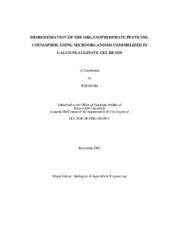| dc.contributor.advisor | Engler, Cady R. | |
| dc.creator | Ha, Jiyeon | |
| dc.date.accessioned | 2007-04-25T20:01:58Z | |
| dc.date.available | 2007-04-25T20:01:58Z | |
| dc.date.created | 2005-12 | |
| dc.date.issued | 2007-04-25 | |
| dc.identifier.uri | https://hdl.handle.net/1969.1/4680 | |
| dc.description.abstract | Coumaphos is an organophosphate insecticide used predominantly by the US Department of Agriculture, Animal and Plant Health Inspection Services for its tick eradication program. Bioremediation of the hydrolysis products of coumaphos, chlorferon and diethylthiophosphate (DETP), using Ca-alginate immobilized cells was the focus of this research. Consortia of indigenous microorganisms capable of degrading chlorferon and DETP were isolated separately. Since chlorferon inhibited both chlorferon-degrading and DETP-degrading organisms, it was not possible to enrich a consortium of organisms for simultaneous degradation of chlorferon and DETP. A two-step growth procedure was developed for degradation studies to provide biomass acclimated to the target compound and reaction medium since cells lost their degradation activity during the growth in a rich medium. Without acclimation, approximately a week-long lag period was required before degradation was initiated. Optimum reaction conditions were found for the degradation of chlorferon and DETP using free cells. Reaction kinetics of chlorferon and DETP were determined using enzyme kinetics because cell growth was not observed during the degradation. Chlorferon degradation followed substrate inhibition kinetics and DETP degradation followed simple Michaelis-Menten kinetics. A calcium-alginate immobilized cell system was developed, and the optimum bead loadings in the reactor were determined. Degradation rates for immobilized cells were enhanced up to five times that for free cells in untreated cattle dip (UCD) solution. The enhanced degradation of immobilized cells was due to protection of the cells from inhibitory substances present in the UCD solution. In addition, physiological changes of cells caused by Ca-alginate immobilization may have contributed to a slightly increased reaction rate in pure solution. Diffusion coefficients of chlorferon and DETP into Ca-alginate gel beads were studied to assist in designing and operating bioreactor systems. Diffusion coefficients of chlorferon and DETP increased with increasing agitation speed and decreasing substrate concentration. Increased cell concentration in gel beads caused lower diffusivity. Calcium-alginate gel beads used in this study were not subject to diffusional limitations. Both external and internal mass transfer resistances were negligible, and the degradation rate inside Ca-alginate gel beads was reaction-limited. | en |
| dc.format.extent | 1149940 bytes | en |
| dc.format.medium | electronic | en |
| dc.format.mimetype | application/pdf | |
| dc.language.iso | en_US | |
| dc.publisher | Texas A&M University | |
| dc.subject | immobilization | en |
| dc.subject | bioremediation | en |
| dc.subject | organophosphate pesticide | en |
| dc.subject | coumaphos | en |
| dc.title | Bioremediation of the organophosphate pesticide, coumaphos, using microorganisms immobilized in calcium-alginate gel beads | en |
| dc.type | Book | en |
| dc.type | Thesis | en |
| thesis.degree.department | Biological and Agricultural Engineering | en |
| thesis.degree.discipline | Biological and Agricultural Engineering | en |
| thesis.degree.grantor | Texas A&M University | en |
| thesis.degree.name | Doctor of Philosophy | en |
| thesis.degree.level | Doctoral | en |
| dc.contributor.committeeMember | Autenrieth, Robin L. | |
| dc.contributor.committeeMember | Kenimer, Ann | |
| dc.contributor.committeeMember | Wild, James R. | |
| dc.type.genre | Electronic Dissertation | en |
| dc.type.material | text | en |
| dc.format.digitalOrigin | born digital | en |


